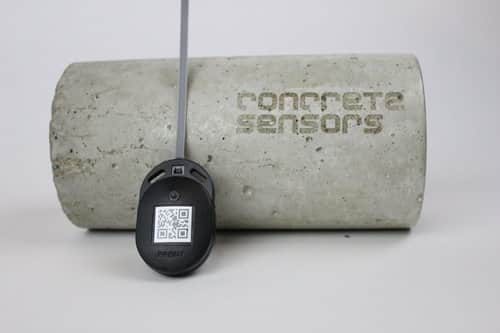Embedded sensors have the power to collect unprecedented amounts of data about the objects and structures that make up our built environment, and it’s hard to imagine a sensor being more “embedded” than one that lives the middle of a block of concrete. And that’s exactly where Brendan Dowdall, CEO of Concrete Sensors, thinks the connected technology of the Internet of Things belongs.
His company sells small, durable little gadgets that attach to rebar, the metal reinforcements around which concrete is poured. As the mixture sets, the sensors measure the internal temperature and humidity — two factors critical to the curing and drying processes that concrete must go through before a building can be completed.
At the curing stage, which takes about a month, water catalyzes an important chemical reaction that makes concrete hard. Hot or cold weather can cause water to evaporate or freeze before the reaction is complete. And once concrete has cured, it needs many more months to dry out before flooring can be installed.
That’s why, if you’re in the construction or flooring industries, Dowdall tells Postscapes, “You should be collecting data on all the concrete you’re pouring.” But existing methods of testing — like drilling holes to take humidity readings — are time-consuming and sometimes unreliable. As a result, Dowdall says, construction firms often schedule much more time for curing and drying than the concrete actually needs. Or they jump the gun and install flooring products that are soon warped or damaged by residual moisture.
“What we’re trying to do is to flip the equation around,” Dowdall explains, “so instead of taking a measurement right before you put the floor down, you have an embedded sensor” that starts taking data the day the concrete is poured. This not only improves scheduling, but can save a lot of money that would otherwise go toward excessive “mitigation” techniques like running fuel-hungry heaters or laying down insulating blankets to keep the concrete warm.
The sensors are made of ABS plastic (the same stuff used to run plumbing and electrical wiring through concrete) and have a generous battery life of more than two years. Dowdall says making the hardware simple and reliable was a priority. “We might as well be sending this to the moon, because we won’t be getting access to it again,” he quips.
Each sensor transmits data using Bluetooth Low Energy, and even through several inches of concrete the signals can be read from ten to 30 feet away. Construction managers can just walk around with a smartphone or tablet to check the concrete’s progress.
The sensor data may also shed light on the way different concrete mixtures behave in real-world conditions. Currently, Dowdall says, choosing the proportions of ingredients in a concrete mix is “kind of a black art” that involves a lot of estimations and educated guesses. The company is developing a library of concrete recipes, so builders can know what to expect and pick the best mixture for each project.
The construction industry has a reputation for being slow to adopt new technologies, so much of Concrete Sensors’ outreach is around educating contractors, design firms, and public sector organizations around the benefits of using connected tech on a worksite.
Dowdall says it’s encouraging that “job sites are being run through iPhones and iPads now,” and his company’s sensors are designed to make early adoption an easy choice. “What we’re trying to do is empower everyone to have this powerful technology,” he says. “Zip-tie it to the rebar, scan a QR code. That’s it.”
Concrete Sensors is a member of the hardware-focused Bolt venture portfolio, which has provided some startup money and lots of industry connections, and the company is now reaching out to angel and seed investors. The sensors are already available for sale online — plan on using about one sensor per truckload of concrete.
Related: TenCate GeoDectect, Real-Time Remote Excavation, Connected Mining, DAQRI

